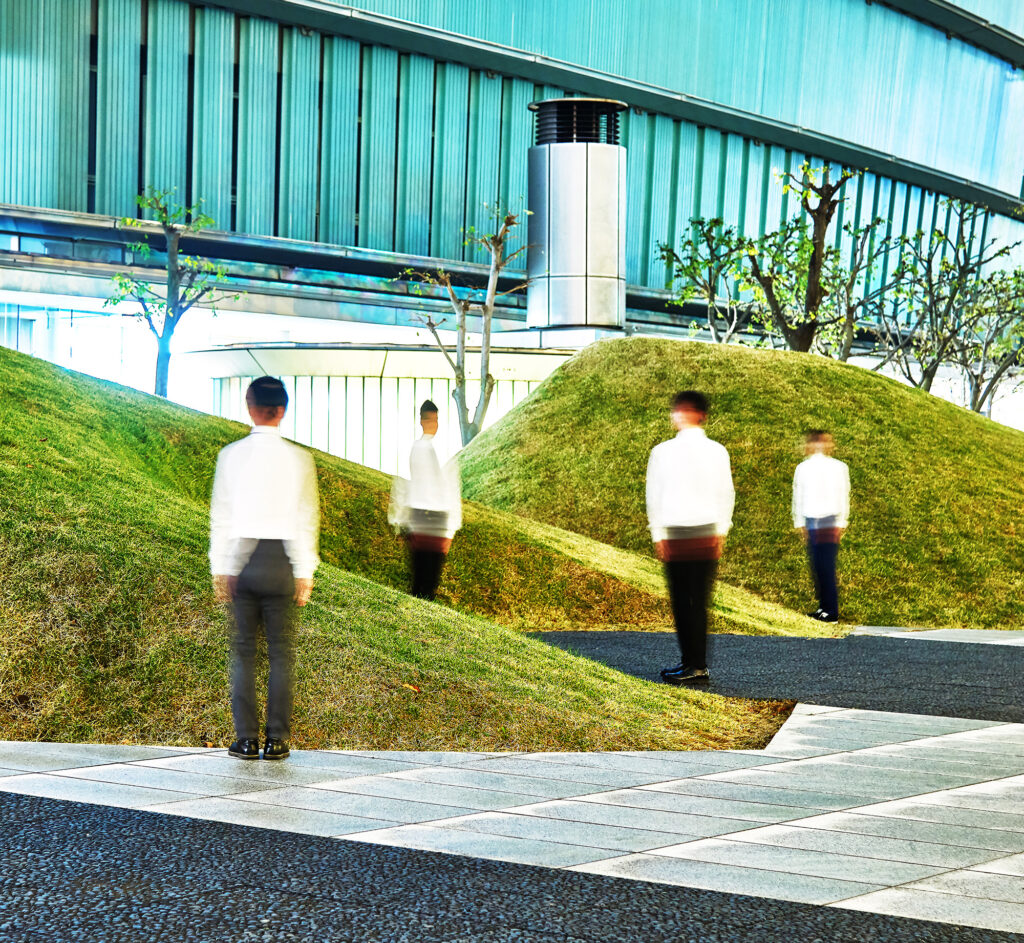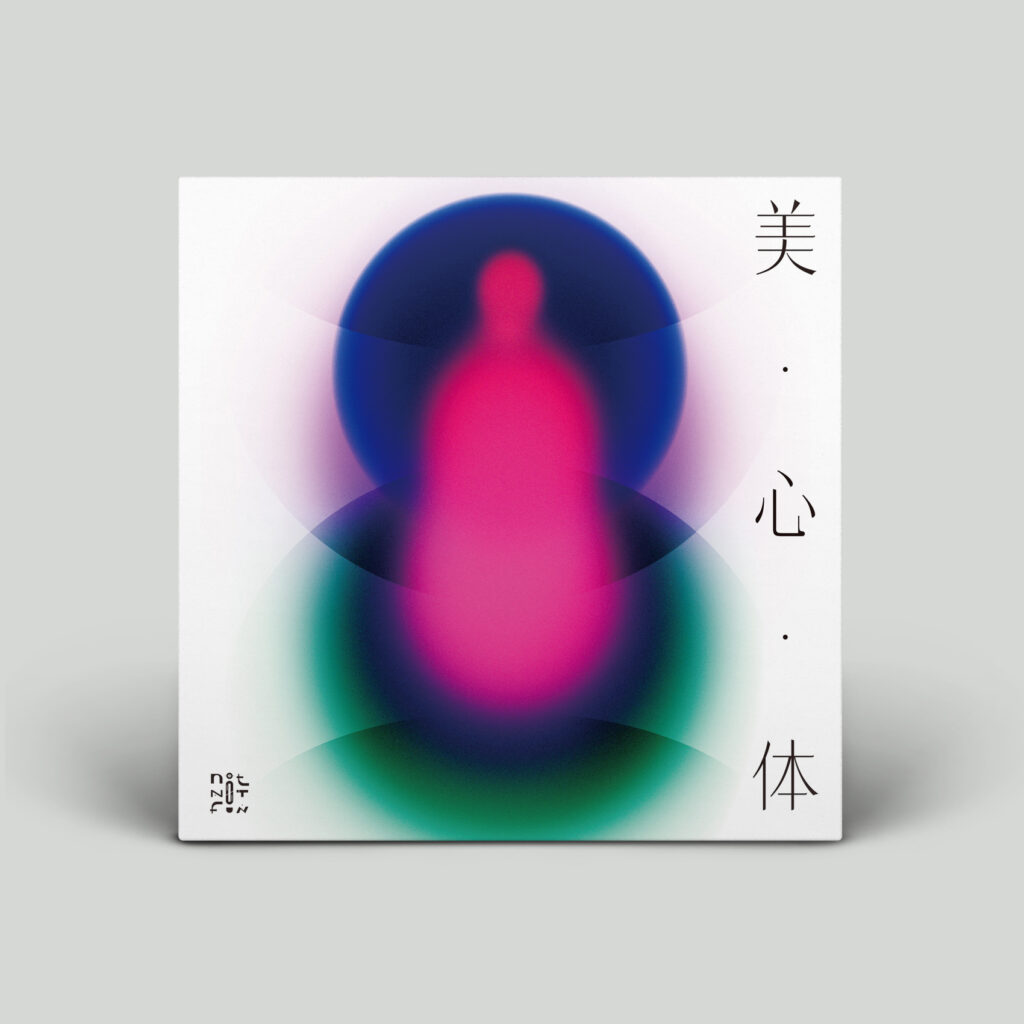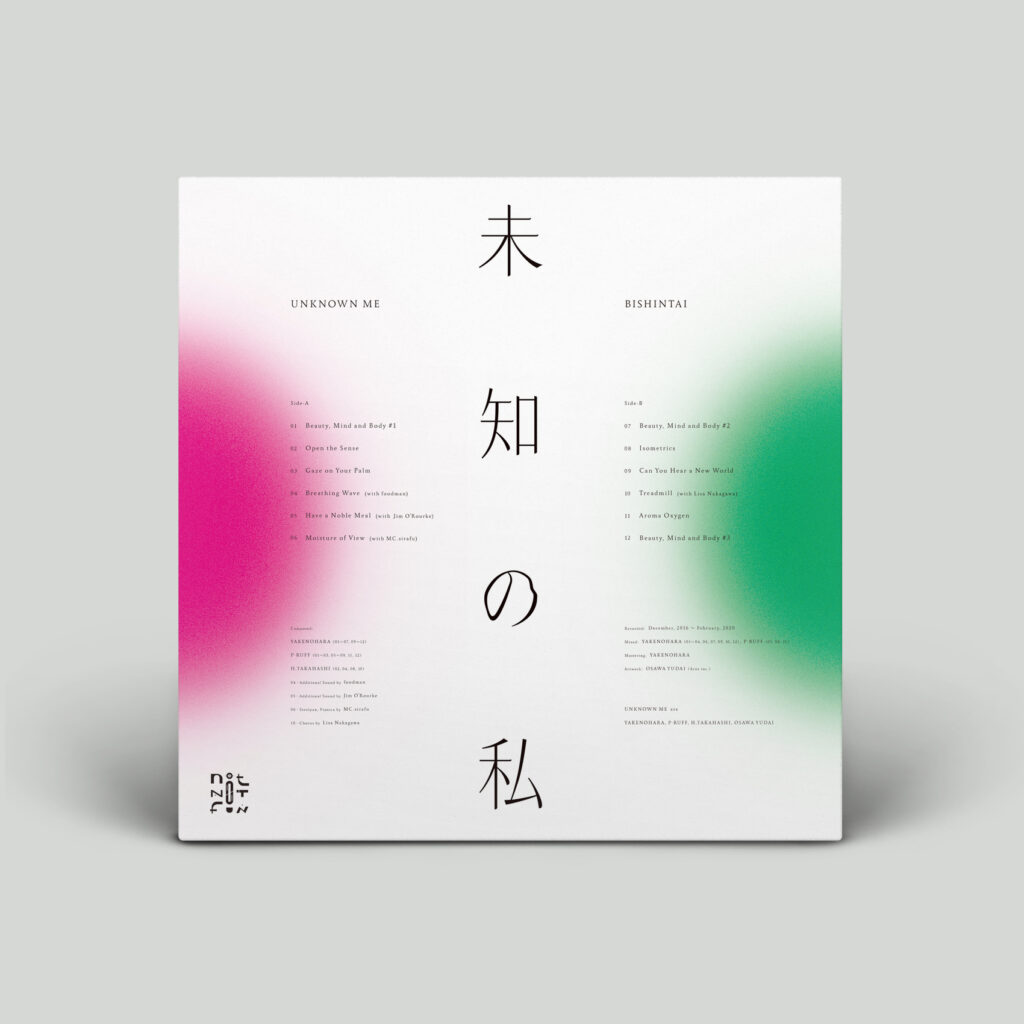UNKNOWN ME is a four-person ambient group made up of Yakenohara, P-RUFF, H. TAKAHASHI (who make the music), and Yudai Osawa, who is in charge of the graphics and visuals. They released their anticipated first LP, BISHINTAI, their fourth release, which features artists like foodman, Jim O’Rourke, MC.sirafu, and Risa Nakagawa. The album is conscious of the gap between each sound; one can describe it as sublimated ambient music with a very acute sensibility of space. We asked the four members to talk about their latest work, made with the theme “to pursue the unknown beauty of the heart and body,” and ambient/new age music, which has been receiving high praise recently.
UNKNOWN ME was born from a gathering to talk about ambient and new age music
—How did you form your unit, UNKNOWN ME?
Yakenohara (Y): We formed UNKNOWN ME around five years ago. People say we’re in a new age revival now, but I didn’t know many people who listened to new age or ambient music. I was friends with DJ P-RUFF-kun, who listened to new age-related music, and H. TAKAHASHI-kun was a mutual friend and musician. We had an opportunity to meet up. Coincidentally, we lived close to each other, so we started drinking and talking about trying our hand at making music.
—I see.
Y: After we released our first tape through our own label, we started doing live shows early on. We thought of incorporating visuals at our live shows, so I asked Osawa-kun, a friend of P-RUFF-kun and mine, to do the visuals. As we played shows together, we were like, “He doesn’t just help us; he’s one of us.” And that’s how Osawa-kun became a member.
—Did you intend on creating ambient or new age music from the get-go?
Y: In a sense, yes. It was like a gathering for ambient music—or what we would call new age revival today—enthusiasts to chat about that type of music. Also, we had released our music on cassette tapes until now. In the beginning, we were set on them because we liked cassette tape releases and the sound textures. H. TAKAHASHI-kun had released his music on tapes already, so I would ask him how he did that. We also spoke about how we wanted to release tapes too.
—You released your first cassette tape through your label, NOPPARA TAPES, and you released another from Not Not Fun from Los Angeles.
Y: Yes. We wrote songs after we released our first tape, but it only took us about a month to finish a 30-minute tape; it took us shorter than we imagined. We talked about how we could make way more and that we wanted to release music abroad.
H. TAKAHASHI (H): We then wondered about whether there was a good label somewhere, and one name that came up was Not Not Fun. Partially because I had purchased and collected their cassette tapes, we reached out ourselves.
—I see. How did you all discover ambient or new age music?
P-RUFF (P): I was influenced by the ambient music that would play on the second floor of clubs. It’s the opposite of busy music, like dance music. I would listen to ambient music as something that cools down [a vibe] that got heated.
Y: Yeah, it was a part of 90s dance music culture. My case is identical to P-RUFF’s. I liked techno. I enjoyed how diverse techno was in the 90s, like how ambient and jungle and everything was mixed with techno. Before I knew it, I was listening to ambient music. It’s as if it’s always been there. I made dance music, but not ambient music, so I wanted to make ambient music for a long time.
H: My background is slightly different, as I first got into krautrock and progressive rock. I listened to a lot of music by King Crimson and Can, and then I listened to Roxy Music and the Talking Heads, which introduced me to Brian Eno. That was in high school or so. When I got into university, I began to listen to electronica and post-rock and dug for CDs at record stores. I collected tapes released in the early 2010s when they were popular. At that point, I thought I could also make my own. So, I started making ambient music.
Yudai Osawa (O): I’ve been listening to rock music since high school, like Jim O’Rourke, who’s on our latest album BISHINTAI, and Fishmans. Looking back, I think I was listening to Fishmans in an ambient way. Like, I understood ambient music as something you could relax to before bed. But recently, I listen to it in a more everyday setting, like during work and such.
What was the appeal of ambient music?
—Why did you listen to ambient music, and why were you drawn to it?
P: I like abstract hip hop, breakbeats, trip-hop, and so on. That kind of music has ambient elements: like omitting major/minor keys to bring out an abstract vibe. I was attracted to that floating feeling.
Y: I got into music because of hip hop and techno. I first became familiar with the musical expression that doesn’t center on the melody—the sound’s vibe is what you make people listen to. Rather than liking music by people such as Burt Bacharach or music with a proper structure, I liked music pertinent to techno. In a way, my ambient sensibility might be at a basic level. Although I had remixed songs to have no beats or produced ambient-ish music, I had never made a full, proper ambient album before UNKNOWN ME. Thinking about it now, maybe I was at a period of my life where I wanted to make calm music that doesn’t possess people’s ego when we started UNKNOWN ME. I was an active dance music DJ until then, but it was like a reaction against that.
H: I was looking for music I can mentally manage whenever I couldn’t sleep, and so I listened to music like Ambient 1: Music for Airports by Brian Eno or Harold Budd. I feel like I got hooked on ambient music that way.
Y:みんな疲れた時にアンビエントを聴きがちになるという。
O:僕も基本的には精神の安定を求めるために聴いていました。でも最近は、精神を落ち着かせるためだけではなく音の質感を楽しむためにアンビエントを聴く機会が僕の中ではすごく増えていますね。
Y: We all tend to listen to ambient music when we get tired.
O: I also listened to it to gain emotional stability. Lately, I listen to ambient music to enjoy its sound texture more, rather than just calming myself down.
—Some people say that ambient music is the sort of music that opens itself up to the environment—essentially, it’s inevitable for it to become a social entity. What are your thoughts on that?
Y: What I feel from having been a dance music DJ for a long time is that the rhythm of dance has a very social element to it. If there’s a rhythm people can relate to, they can connect and understand one another, even if the music has differing sonic factors. In contrast, I think ambient music is the type of music that people don’t have to bond over. So, I don’t think I view ambient music as a social thing.
O: I feel like I listen to ambient music as a place to escape. Rather than connecting to society, I enjoy it as something that’s a bit cut off from it. That act itself might be social, though.
H: I’ve never really given thought to how ambient music is inevitably social or anything. But I think it’s interesting how a new sensibility and way of listening are being born because people use ambient/new age revival music as the base and mix it with other genres.
Thoughts on new age revival
—What do you think about the recent new age revival?
Y: I Am the Center (Private Issue New Age Music in America, 1950-1990), released through Light in the Attic, and the first and second album released on Music From Memory excited me. As a listener, there are more choices now.
P: Everyone would often talk about how new age music was the last rare groove. It might be an exaggeration to say we’ve uncovered all the existing Japanese music, but more labels now introduce new age music, which was previously untouched, interestingly. I began to think it was impressive the more I listened to it.
—What are your views on how Kanyō Ongaku, featured on Kankyō Ongaku: Japanese Ambient, Environmental & New Age Music 1980-1990, released by Light in the Attic,became highly valued?
P: I like that compilation album. I love Haruomi Hosono-san’s music, and I never really listened to an album with the sound textures of the music he composed for Muji. So, it was quite fascinating. Also, one of the editors, Spencer Doran, is very knowledgeable about Japanese music, and I feel like he has a skilled understanding of aesthetics.
Y: I don’t have a personal attachment to that compilation album. I had already been listening to Hiroshi Yoshimura-san and others on the compilation album before their album prices shot up. When that compilation album came out, I was like, “Well, this is it.” We had already put out some music as UNKNOWN ME, so I was worried that people might consume our music as a trend because of the compilation.
—H. Takahashi-san, I feel like your music is influenced by Hiroshi Yoshimura-san, Satoshi Ashikawa-san, and such. Is it?
H: I get told that a lot, but when I started making music, I didn’t know about them at all. I listened to their music and understood how people might think they influenced me. Regarding the compilation album: I had already known most of the [featured artists] before it came out, but I thought it was good.
On BISHINTAI, filled with pretty sounds and “spaces where something is emerging”
—I’d like to know about your latest album, BISHINTAI. I heard the theme of this album is “to pursue the unknown beauty of the heart and body.”
Y: Originally, we organized an ambient event after releasing a couple of tapes and playing live. We named the event “Bi・Shin・Tai.” We got Moodman-san, Koji Nakamura (Nakako), and MC.sirafu and Risa Nakagawa-san’s unit, Utsukushikihikari, to play. This event was our jumping board; everything started with choosing beauty as the concept for the event.
O: We had massages and other content related to beauty at the event.
Y: Yeah. We didn’t want it to be an overly hardcore ambient event. We spoke about how we wanted it to be open, and the concept of beauty came up.
—Compared to your previous work, it sounds like this album is more minimal. It’s as though you were mindful of the spaces between each sound. How conscious were you of that?
Y: The previous album is called Astronauts, but we worked on BISHINTAI before Astronauts. So, we didn’t have a clear order of creating the album and releasing it. We didn’t think too deeply about being minimal. But because the concept is on beauty, we were trying to produce a pretty sound.
P: We produced this album over a long period, so it was like we cut the sounds down during that time.
Y: In terms of being minimal, our songs don’t have chord progressions that change the feeling of said songs, so I think we’ve always considered our music to be minimal overall.
—Right. It seems like you filled the blanks with sounds on your previous albums while you subtracted them on this one.
Y: That might be true. Perhaps we’re getting better at creating ambient music. For example, consider the pitch and harmony as the vertical axis and the sounds and spaces between them (rhythm) as the horizontal axis. Instead of making the listener feel like something is missing between the huge spaces [between sounds], we create spaces where something is emerging and nothingness that’s present. I didn’t understand it five years ago, but when we were making BISHINTAI, I feel like we were working forever on creating those spaces skillfully. Five years ago, I didn’t think about that; I was naïve. In that way, this album is a step forward for us.
The guests who provided variety to the work
—This album features foodman, Jim O’Rourke, MC.sirafu, and Risa Nakagawa. What role did they have on the album?
H: This is an objective thing to say, but by inviting people with different music styles who can do things we can’t technically do, as seen in MC.sirafu-san’s steel drums and Nakagawa-san’s vocal choruses, we created an album rich in diversity. With foodman-san, he inserted a rhythm we couldn’t come up with, and I feel like our song [with him] sounds different from our past songs.
P: We often use synths and samplers to make music, and no one’s too good at playing any instruments. By having instrument players on the album, our music style expanded.
Y: How did the music sound to you, Osawa-kun?
O: Compared to our past releases, this one has a bit of an extravagance. There are many types of ambient music out there today, and it feels like this one could fit right in.
Where the album stands
—Your album has an ambient ring that feels like it exists as an extension of everyday life.
P: Concerning everyday life, whenever we make music, we often make it in our room or other members’ rooms. We get together, work, and then drink and eat. Instead of going into a studio like, “Alright, let’s get to work,” we make music in a laidback way. Perhaps we’re unconsciously reflecting that into our music.
Y: We made this album while being mindful of the texture of the sounds. It’s not like we imagined a fantastic place and chipped that down to express something.
P: With our previous works, we would choose a theme and express an exotic vibe—or the distance between said vibe and us. Ultimately, the [idea of] exoticism is about distance. So, I think there’s a gap between [the sound] of every album of ours and the theme.
Y: Yeah. We express ourselves through our work, but it’s like we conceive them objectively. With this album, we made something towards our shared idea of beauty.
—Last, if you were to place BISHINTAI on your record shelf, which records will be next to it?
Y: I want to put it in between ambient, contemporary music, and 80s UK music. So, it would go between Susumu Yokota’s Sakura and the Durutti Column.
P: Gigi Masin’s Talk to the Sea and Wilson Tanner’s 69.
O: This album sounded extravagant when I first listened to it, so the Beatles’ Sgt. Pepper’s Lonely Hearts Club Band and Aphex Twin’s Selected Ambient Works 85-92.
H: Dip in the Pool’s 12-inch, released via Music From Memory, and Oneohtrix Point Never’s R Plus Seven.
—Thank you!
*
UNKNOWN ME
UNKNOWN ME is a four-person ambient unit comprised of Yakenohara, P-RUFF, H. TAKAHASHI, who create the music, and Yudai Osawa, who’s in charge of the graphics and visuals. With the concept “to build someone’s imagined landscape,” they use their imagination and go back and forth between time and space to create various emotions and landscapes via ambient music, new age, and Balearic music. In July 2016, they released their debut tape, SUNDAY VOID. In November 2016, they released their 7-inch AWA EP, in February 2017, they released subtropics, focused on subtropics, via the LA-based independent label Not Not Fun, and in December 2018, they released ASTRONAUTS, a concept album on astronauts,from the same label. FACT Magazine from the UK shed the spotlight on subtropics. UNKNOWN ME has played for the pioneer of ambient revival music Gigi Masin’s show in Japan and MUTEK, the esteemed electronic music and digital art festival. In April 2021, they released their long-awaited first LP, BISHINTAI, a piece of Kankyō Ongaku for city dwellers, based on the theme of the unknown beauty of the heart and body.



